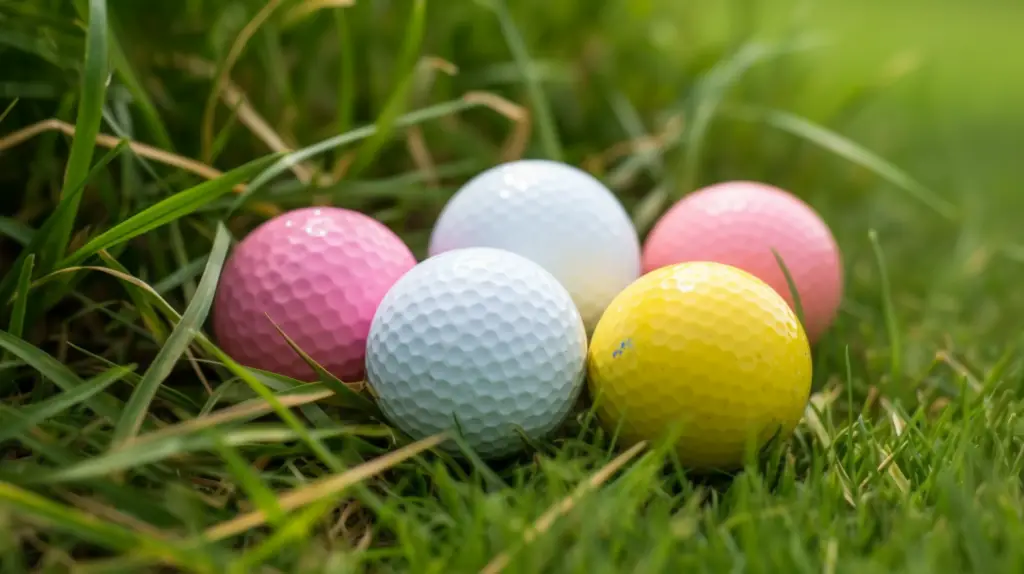Last Updated on January 29, 2024
Golf, frequently praised as a sport characterized by tradition and precision has experienced an intriguing transformation in recent decades due to the introduction and evolution of golf balls in various colors. In the past, the fairways were predominantly graced by immaculate white balls. However, a diverse range of vivid colors has surfaced, serving not only as a novelty but also as a substantial factor in improving performance. This article extensively explores the extensive history and evolution of colored golf balls, mapping their progression from being regarded solely as novelties to evolving into a legitimate option for golfers aiming to combine style with functionality.
Origins of the White Golf Ball
Golf can be traced back to the Scottish hills in the 15th century, where early ‘golfers’ played with colorful leather and feather-stuffed balls. However, a seismic shift occurred with the advent of the rubber-core golf ball by the Coburn Haskell company in 1905. This innovation marked the inception of the standard white golf ball, a choice that would dominate the sport for decades.
Enter Yellow Golf Balls
As the game of golf evolved, an inherent challenge with the traditional white golf ball became apparent – visibility. Particularly in conditions of low light or overcast weather, tracking shots became a frustrating ordeal, often resulting in lost balls and mounting player frustration. The 1970s witnessed a pioneering attempt to address this issue when the Spalding company introduced the Executive, a yellow golf ball. Although initially perceived as a novelty item, it laid the foundation for more serious considerations in the colorful golf ball arena.
Titleist, a prominent player in the golf equipment landscape, seized the opportunity in 1984 with the introduction of the Titleist Professional 90 – a yellow version of their renowned Professional golf ball. This strategic move validated the notion that colored golf balls could offer both visibility and performance, establishing a firm foothold for their future integration into serious play.
Ping Golf Balls and the Quest for Quality
During the 1970s, the golfing sphere experienced the introduction of Ping, a well-known producer of top-tier golf clubs, into the market for colored golf balls. These golf balls, characterized by a soft texture and remarkable distance, swiftly captured the interest and favor of golf enthusiasts. Nevertheless, this auspicious undertaking underwent an unforeseen twist when, in 1999, Ping halted the production of their golf balls. This transformed the available ones into highly desired collector’s items and created a gap in the colored golf ball domain.
A Spectrum of Choices
The early 1990s saw a significant departure from the traditional as pink golf balls made their debut during the LPGA Tour’s Phar-Mor at Inverrary tournament. Conceived to heighten awareness for breast cancer research, these rose-colored balls represented a deviation from the norm and showcased the capacity of golf balls as a platform for societal issues. In 2001, Wilson Sporting Goods leveraged this sentiment by unveiling the Hope ball, allocating a fraction of its earnings to support the Susan G. Komen Breast Cancer Foundation.
As the 2000s unfolded, orange and green golf balls took center stage. Volvik, a key player in the golf ball manufacturing arena, spearheaded the mass production of orange balls specifically designed for serious golfers. TaylorMade and Callaway followed suit, introducing their versions of orange and green balls and expanding the color palette available to golfers.
Truvis Pattern
In 2016, a revolutionary breakthrough occurred with the introduction of the Callaway Chrome Soft Truvis golf ball. Showcasing a unique pattern reminiscent of a soccer ball, the Truvis design not only captured the attention of golfers aesthetically but also fulfilled a practical role. This distinct pattern improved the visibility of the ball’s spin and direction, furnishing golfers with crucial information for executing more precise shots.
Glow in the Dark Golf Balls
The 1990s witnessed a captivating addition to the golf ball range – glow-in-the-dark golf balls. Designed for nocturnal play, these radiant orbs introduced a fresh perspective to the game. Recent technological progress has led to the availability of glow-in-the-dark golf balls in diverse colors and designs, infusing an aspect of enthusiasm and enjoyment into the sport, persisting well beyond sunset.
The Pros and Cons of Colored Golf Balls in Professional Play
While colored golf balls have become an integral part of many amateur golfers’ arsenals, the professional circuit has maintained a conservative stance. Governing bodies such as the United States Golf Association (USGA) and the Professional Golfers’ Association (PGA) Tour currently prohibit the use of colored balls during official competition rounds. Rules explicitly state that approved balls must be white and adhere to specific standards concerning size, weight and initial velocity.
Pros of Colored Balls in Professional Play
Visibility Enhancement: Colored balls offer superior visibility against various backdrops, aiding both players and fans in tracking shots.
Alignment Assistance: The distinct colors of the balls can provide alignment assistance, similar to how certain patterns aid other sports professionals.
Marketing and Branding: Professional players can strategically choose balls matching their gear colors and sponsor logos, contributing to marketing and branding efforts.
TV Broadcast Visibility: Colored balls can significantly enhance visibility on monochrome TV broadcasts compared to traditional white balls, which might blend into certain backgrounds.
Potential Technological Advancements: The use of colored exteriors enables golf ball manufacturers to explore new technologies using pigments and coatings tailored for performance enhancement.
Cons of Colored Balls in Professional Play
Tradition and Uniformity: White has been the accepted standard for nearly a century and introducing colored balls may disrupt the traditional aesthetic of the game.
Potential Competitive Advantages: Allowing different colors could lead to players optimizing their choices for specific conditions, potentially creating a competitive imbalance.
Performance Alterations: Colored coatings may affect performance factors such as spin, durability and visibility as they deteriorate over time.
TV and Photographic Aesthetics: Changes in the visual representation of the game on TV and photographs might impact viewer familiarity and engagement.
Focus on Skill vs. Equipment Variation: A conservative perspective emphasizes the maintenance of white golf balls as a tradition that keeps the professional focus on skill rather than variations in equipment.
Conditions Influencing Colored Ball Benefits
The potential benefits of colored golf balls extend beyond their aesthetic appeal to practical advantages under specific conditions. Here are scenarios where colored balls could offer enhanced visibility and competitive benefits:
Lower Light Tournaments: Bright colors illuminate in dim conditions, providing better visibility during lower light dusk and night tournaments.
Overcast, Foggy or Rainy Weather: Colored balls stand out through gray shadows and precipitation, offering improved visibility.
Lush Green Fairways or British Open Links Layouts: White balls may disappear against some backdrops, while colored balls remain conspicuous on lush green fairways or British Open links layouts.
Colder Climates with Snow Galleries: Colored balls pierce through snowy backgrounds, offering better visibility in colder climates with snow galleries.
Difficult Tee Shots into Brush and Woods: Alternate colors remain visible for a longer duration in flight, aiding in tracking shots into brush and woods.
Senior Tournaments with Older Fans: Brightly colored balls aid viewing for older fans in senior tournaments.
Television Broadcasts: Certain colors transmit better on camera, contributing to better visibility during televised broadcasts, depending on contrast and graphics.
The Future of Colored Golf Balls in Professional Play
While the professional golfing establishment remains rooted in tradition, there is a growing recognition of the potential benefits that colored golf balls can bring to the sport. Although current rules strictly prohibit the use of colored balls during official competition rounds, there is room for potential evolution. The future may witness small, incremental changes that allow the professional game to test the impacts of colored golf balls while preserving traditional norms and maintaining competitive balance.
Potential Future Scenarios
Colored Balls in Practice Rounds: Allowing colored balls during practice rounds could provide professionals with alignment and branding benefits without disrupting official competitions.
Colored Balls in Skills Competitions: Permitting colored balls for skills competitions, such as long-drive contests, could inject excitement without affecting the integrity of official tournaments.
Pro-Am Events with Colored Balls: Introducing pro-am events alongside tournaments that use colored balls at the amateur’s discretion could boost sponsor interest and fan engagement.
Limited Rules for Colored Balls: Individual tours or events might implement limited rules allowing colored balls under specified conditions, such as night tournaments or specific weather scenarios.
Exemptions Based on Medical Conditions: Players with medical conditions affecting visibility, such as color blindness, could petition for exemptions to use colored balls during official competitions.
Specially Marked Colored Balls for TV Coverage: Using specially marked colored balls for shot tracing on TV coverage while players still use white balls could be a compromise that maintains visual consistency while exploring technological advancements.
Specialty Teams or Exhibition Events: Launching specialty teams or exhibition events that allow the use of colored balls could attract new fans and offer an avenue for experimentation.
Conclusion
The evolution of colored golf balls from being perceived as novelty items to becoming serious considerations for performance enhancement reflects the dynamic and adaptive nature of the sport. Tradition and conservatism persist in the professional arena, but the broader golf industry has warmly embraced colored ball technology. The potential for small, incremental changes in professional play hints at a future where the rainbow of colored golf balls may make a nuanced return.
As technology advances and golfer preferences continue to evolve, the colorful journey of golf balls promises an exciting and dynamic chapter in the ongoing narrative of this timeless sport. Whether it’s the visual spectacle of brightly colored balls against the backdrop of lush green fairways or the practical advantages they offer in challenging conditions, colored golf balls are poised to continue leaving their mark on the game of golf, combining tradition with innovation in a harmonious blend. As golfers tee off into the future, the horizon holds the promise of a vibrant and diverse landscape, where the rainbow of colored golf balls shines bright on the ever-changing canvas of the golfing world.



